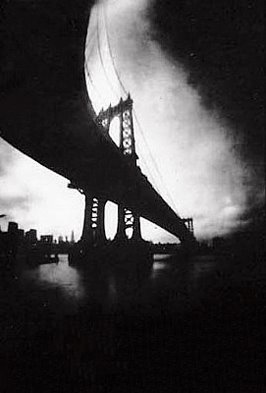Orchestra of Bridges

[Image: Michel Bayard].
Singing Bridges seeks to record, using contact microphones, the sounds of various bridges: stressed cables, rumbling footplates, geotechnical strain.
It's all about playing "stay-cabled and suspension bridges as musical instruments."
The artist's own justification for the project leaves a bit to be desired – claiming it has something to do with global information flow and Indra's Net – but the musicalization of urban infrastructure is something that totally fascinates me, and it's popped up on BLDGBLOG before.
If we can go back to Coleridge for a second, and imagine him striding across the retractable bridges of Chicago, iPod in hand, plugging himself into the audial foundations of the city, the trembling of concrete and iron, how every atom vibrates, Aeolian, strummed by the world; or Coleridge wandering London, stepping onto the Thames foreshore, microphones ready, pushing away sand to record the passing of subterranean trains (or whalesong, for that matter); or, yet again, perhaps somewhere in the scoured volcanism of rural Iceland, contact mics taped down on the surface of the earth, Coleridge stands listening to the Atlantic expand, every subtle rumble of tectonic plates spreading; then the bridges of the world, specifically built for how they sound, humming in the wind, can join in – and it's worth considering that the vibrations of a bridge's pillars might record themselves in patterns in the subsurface soil, small figures of agitation inscribed into the earth, and that those might fossilize, and in a million years you'll have a musical score hardened into rock, sandstone evidence of how the earth once sounded, back then, which is now: a planet covered with bridges, vibrating in the wind.
(Singing Bridges spotted at Ruairi Glynn's excellent Interactive Architecture dot Org).





Comments are moderated.
If it's not spam, it will appear here shortly!
i'd just like to point out that Star Wars sound designer used the vibrating of bridges (Golden Gate?) extensively to craft the distinctive hum of lightsabers.
ah, forgot to add that his name is Ben Burtt.
A looong time ago, before hyperlinks, there was a story about someone who thought he could re-create George Washington's voice in the sonically-altered patterns of paint in his portraits. Perhaps something like that is possible on a non-destructive basis, and at that point, I'd be interested to hear what went on at Lascaux, in Egyptian, Inca and Aztec temples, at Pompeii, and the mutterings of Hieronymous Bosch. Go even further back, to patterns embedded in the mud of primordial puddles, craters of asteroids, and imprinted on the very fabric of space. I think someone has even done a sonic impression of the Big Bang, sped up.
Wouldn't you get the voice of the artist--and then everyone who'd ever handled the work--instead of GW (who probably had little to do with the various products of image facture which we today identify him with)?
The idea is that sound waves make impressions in the pain as it dries - but not afterwards. So yeah, you'd get the artist as well, along with whatever other noise was happening.
Billy, I didn't actually know that, but now that I do I feel like renting Star Wars just to listen...
I remember once a housemate of mine at uni found out that the sounds of Robocop - his electronic armor and robotic prostheses - were made by recording VCRs ejecting tapes.
And, e-tat, someone has indeed done audio work with the Big Bang, I'll look around for it. The BBC has stuff like that on it all the time, though, it's fascinating. The sounds of stars and what not. An older post on BLDGBLOG has the sounds of icebergs, if that interests anyone. It's the piece on "London instrument." Which is very similar to this post, mind you.
Anyway, thanks for the comments!
Post a Comment